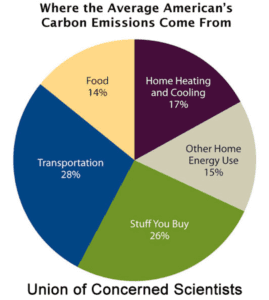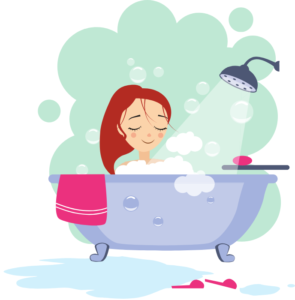
Back in the day, when I was interviewing college kids for full-time employment with us, I would ask them to tell me about things they have done in their personal experiences to save energy. The purpose was twofold, 1) do you dig efficiency, or are you just looking for employment – any employment, and 2) creativity. I thought I had everything covered, but some real zingers gave me a chuckle. It’s too bad I cannot recall them at this time. Nevertheless, I came across an old paper that appears to have been published for an ACEEE Summer Study in 1994, “The Conservation Potential of Lifestyle Changes.”
Wow! There is a lot to cover here, so let’s get moving, starting with this next chart that shows where we use energy and the resulting release of carbon dioxide. Carbon is a good measure because it relates to source energy and in many ways is similar to dollars spent by end-use. The chart nearby shows how emissions break out per household, circa 2012. Note that 92% of the transportation is by automobile, and the rest is by air and others.
32%
I would bet that when people think of cutting their energy use, they think about their home. Pffft. Homes only account for a third of the average household energy consumption and emissions. Forty percent of the average person’s emissions are from stuff purchased. Americans throw away an astounding 30-40% of their food. There you are. You can work your tail off and freeze in the dark to save energy in your home, or you can stop throwing food away. Food waste is one of the things that drives me crazy. The date on food is “best when purchased by __” not “will turn to botulinum and kill you by __.”


As for your stuff, buy an old house with tiny closets and no storage space for crap. It’s like my computer bag and wallet in matching colors. They are tiny, forcing me to limit what I lug around.
It’s good for my spine to boot. Try it. I’m looking out for your back and your wallet at the same time.
Pun intended.
1994 Lifestyle Change Suggestions
The paper linked above provides a list of lifestyle changes for individuals to save energy – some of which are humorous.
- Using hot water bottles in cold weather is above my paygrade. Apparently, people filled these flexible-rubber things to stay warm in bed. The problem – it’s cold in the middle of the night. An electric blanket would be a better choice to supply heat directly at the load, the human body. Direct and precise delivery of energy-consuming equipment is a common benefit I use to describe electrification in manufacturing.
- Dress appropriately is a reason I prefer northern climates over hot climates. I can adjust with clothes in cold weather, but there are no options when the outdoor air temperature is higher than body temperature. However, if you go to a conference in a hot climate, bring sweaters and blankets because they like to refrigerate those spaces. Am I right? Yes. I don’t think this is what they had in mind for this suggestion.
- Use kitchen and bathroom exhaust fans sparingly in winter. This one is ok if you have a leaky home, but tight ones will present condensation problems on windows. For that matter, if you ever build or move into a new home, ventilate the heck out of it for at least six months. The concrete takes up to a year to stop emitting water vapor.
- Loading room air conditioners on the north side of the home. This one is interesting as the unit will operate more efficiently, but it is ignorant from a comfort perspective. Depending on trees and other shading, the west exposure will have the greatest need for cooling. As noted above, for comfort, supply heating or cooling where the load is; not the north face for cooling.
- Fill the basin to wash hands. First, someone needs to tell the plumbing fixture manufacturers to make a decent sink stopper mechanism. They are the chintziest mechanisms imaginable, and they stop working in about 14 months. Second, dude, who needs that much water to wash hands?
- Close vents (heating and cooling) in unoccupied rooms. This one is a losing proposition with negligible impacts. I’ll spare the two dozen offsetting factors. Thank me.
- Water heater blankets were not mentioned in the paper, but I mention them because of bogus claims and invite any feedback. Water heater manufacturers say the warranty is void if you install a blanket. Why? Because they like to void warranties. What craps out on a water heater? The tank, heat exchanger, or heating coil. Do any of these things know a blanket is on the outside? No. What a crock. Besides, everyone knows water heaters crap out within months of warranty expiration. It’s a finely planned failure.
I’m going to end with three zingers.
- Bathe less. Talk amongst yourselves.
- Take cooler showers. Sure thing! This reminds me of something significant for end-use studies. Most energy analysts default to assuming water heating loads are constant year-round. They isolate gas consumption in summer and project that to be the water heating load all year. That’s not the way it works. People use more hot water in the winter – longer, hotter showers.
- And the best for last (I can’t believe this was in a conference paper): Share bath and shower water. How does one share shower water and save energy?






